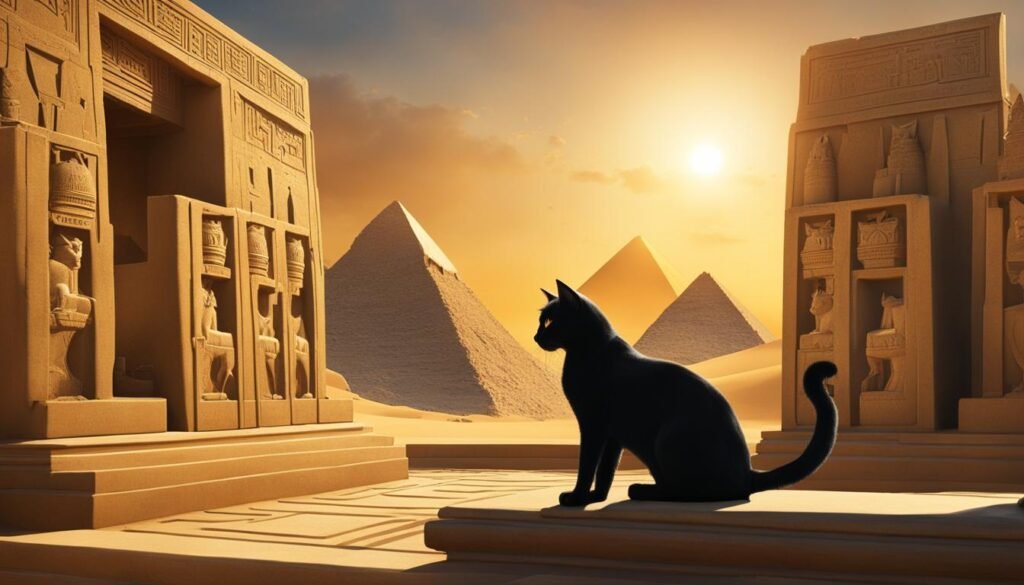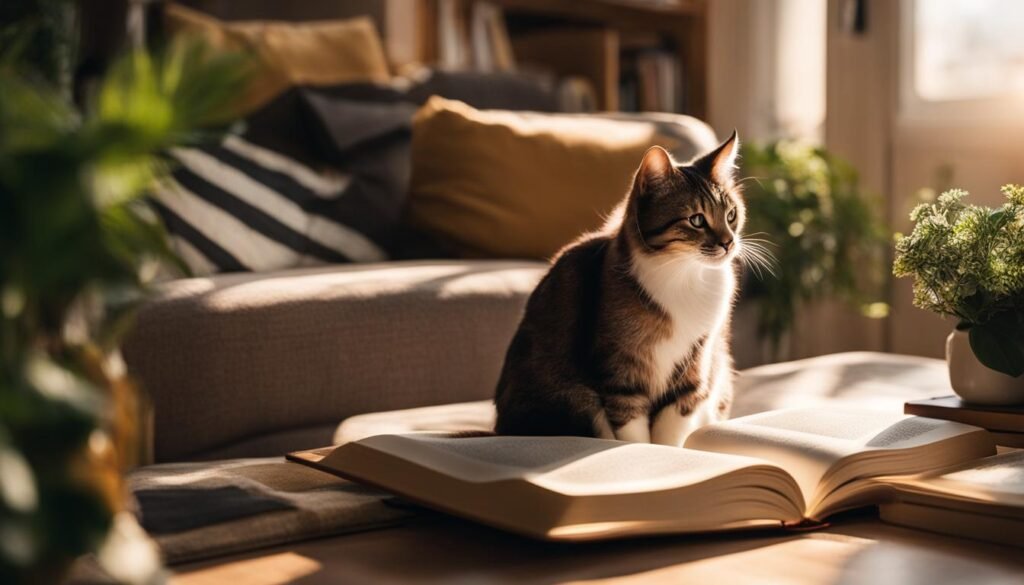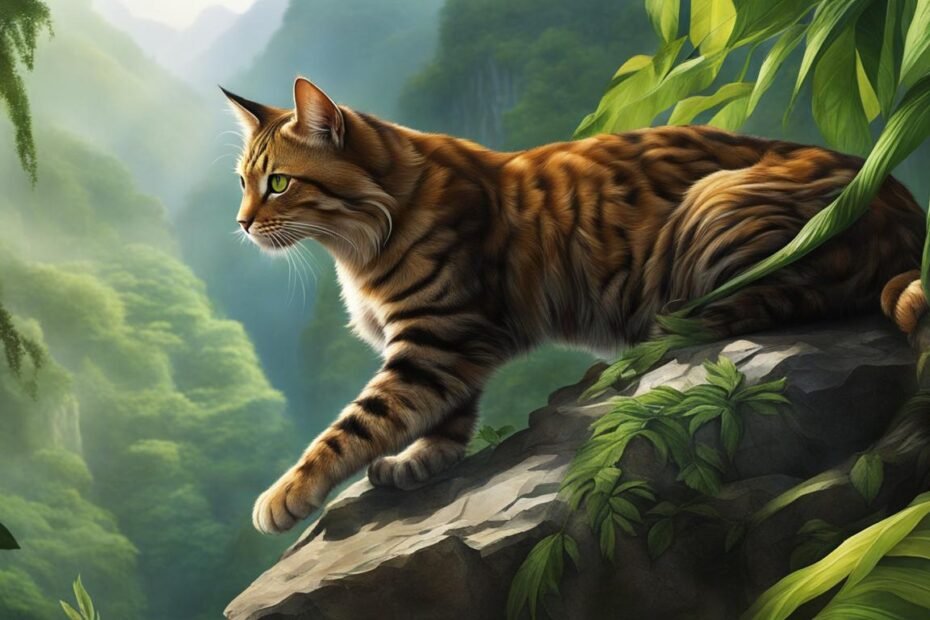Welcome to our exploration of the fascinating journey of cat evolution as pets. Cats have a rich history of companionship with humans, evolving from their wild ancestors to become beloved members of our families. They share a common ancestry with wildcats, particularly the African wildcat. Ancient civilizations such as Egypt, Greece, and Rome held cats in high regard and even worshipped them. Throughout history, cats have left their mark on cultural narratives, appearing in folklore, mythology, and religion.
Over time, cats transitioned from working cats, primarily used for rodent control, to valued family members. The development of cat breeds and breed standards has contributed to the diverse range of feline companions we have today. Let’s embark on this captivating journey to uncover the origins, cultural significance, and development of cats as pets.
Key Takeaways:
- Cats have a long history of companionship with humans, evolving from their wild ancestors.
- Ancient civilizations such as Egypt, Greece, and Rome held cats in high regard and worshipped them.
- Cats transitioned from working cats to valued family members over time.
- The development of cat breeds and breed standards has led to a diverse range of feline companions.
- Our journey will explore the origins, cultural significance, and development of cats as pets.
Ancestral Lineage and Domestication of Cats
The origins of domestic cats can be traced back to a common ancestor with wildcats, specifically the African wildcat. Research suggests that early domestication began when wildcats were drawn to agricultural settlements due to the abundance of rodents. Cats and humans found a mutually beneficial relationship as cats helped control the rodent population, and humans provided a steady food source. This marked the beginning of the domestication process, as cats gradually adapted to living alongside humans.
Over time, cats became companions in ancient civilizations, where they held cultural significance and were even worshipped in some societies. The Egyptians, in particular, revered cats and associated them with fertility and protection. Cats are often depicted in ancient Egyptian art and mythology. In Greek and Roman societies, cats were admired for their agility and grace, often being associated with deities such as Artemis and Diana.
The domestication of cats started when wildcats were drawn to agricultural settlements due to the abundance of rodents.
Today, cats have evolved from their wild ancestors to become beloved pets in households around the world. The domestication process has resulted in cats with various temperaments, coat patterns, and physical characteristics. These traits have been further enhanced through selective breeding, leading to the development of different cat breeds with distinct attributes.
| Breed | Origin | Traits |
|---|---|---|
| Maine Coon | United States | Large size, tufted ears, and a shaggy coat. |
| Siamese | Thailand (formerly Siam) | Blue almond-shaped eyes and a distinctive color-point pattern. |
| Persian | Persia (now Iran) | Long, luxurious coat and a round face with a flattened nose. |
As the bond between cats and humans continues to strengthen, we appreciate the remarkable journey of feline evolution as pets. From their ancestral lineage with wildcats to their domestication process and the development of different breeds, cats have carved a special place in our hearts and homes. While cats have adapted to living indoors in modern times, it’s important to recognize their biological instincts and provide them with enriched environments that cater to their natural behaviors.
References:
- “The History of Domesticated Cats | PetMD.” PetMD, www.petmd.com/cat/general-health/history-domesticated-cats.
- “From Wild Cat to House Cat.” American Museum of Natural History, www.amnh.org/exhibitions/permanent-exhibitions/hall-of-biodiversity/biodiversity-case-studies-from-the-field/from-wild-cat-to-house-cat.
- “Cat Breeds: Recognized Cat Breeds with Descriptions.” The Cat Fanciers’ Association, www.cfa.org/breeds.
Cultural Significance of Cats
Cats have played significant roles in various ancient civilizations, leaving a lasting cultural impact. In ancient Egypt, cats held a revered status and were considered sacred animals. They were associated with the goddess Bastet, who was the patron of home, fertility, and protection. Egyptians believed that cats possessed magical powers and brought good fortune to their households. The reverence for cats in ancient Egypt is evident in their art, literature, and religious practices. Cats were often depicted in tombs, sculptures, and paintings, emphasizing their importance in Egyptian society.
The ancient Egyptians worshipped cats and believed they had protective qualities. Cats were highly regarded for their ability to ward off evil spirits and protect homes from harm. They were even mummified and buried alongside their owners as a sign of respect and to ensure their companionship in the afterlife.
In Greek and Roman cultures, cats were admired for their grace, agility, and hunting skills. They were associated with deities such as Artemis (Greek) and Diana (Roman), both goddesses of the hunt. Cats were often depicted in ancient Greek and Roman art, showcasing their presence in everyday life. The Greeks especially admired cats for their ability to catch mice and other pests. Cats were also believed to bring good luck and fortune, making them popular companions in both societies.
Throughout history, cats have consistently held a special place in the hearts and minds of humans. Their cultural significance is a testament to the unique bond between cats and humans, which continues to this day.

The Cultural Significance of Cats in Ancient Egypt:
| Aspect | Significance |
|---|---|
| Divine Association | Cats were linked to the goddess Bastet and revered as sacred animals. |
| Symbol of Protection | Egyptians believed that cats had the power to ward off evil spirits. |
| Representation in Art and Literature | Cats were prominently featured in Egyptian tombs, sculptures, and paintings. |
| Mummification and Burial | Cats were given elaborate burials to ensure their companionship in the afterlife. |
The Cultural Significance of Cats in Greek and Roman Societies:
- Cats were associated with deities Artemis and Diana, both goddesses of the hunt.
- Cats were admired for their hunting skills and ability to catch pests.
- Cats were considered bringers of good luck and fortune.
- Depictions of cats in ancient Greek and Roman art reflected their presence in everyday life.
The Development of Cat Breeds
Cat breeds have evolved over time through the process of selective breeding. Breeders recognized and appreciated unique traits in certain cats and intentionally bred them to perpetuate those characteristics. This has resulted in a diverse range of cat breeds with distinct appearances, temperaments, and personalities.
Breed standards have been established to maintain breed integrity and outline the ideal physical attributes and temperaments for each breed. These standards serve as guidelines for breeders and judges in cat shows and competitions. They ensure consistency in breed characteristics and allow for fair comparison and evaluation of cats.
“Cat shows and competitions provide a platform for showcasing different cat breeds and promoting breed preservation. They allow breeders and cat enthusiasts to come together, share knowledge, and celebrate the beauty and uniqueness of each breed,” says Jane Peterson, a veteran cat breeder and judge.
Table: Popular Cat Breeds and Their Characteristics
| Breed | Appearance | Temperament |
|---|---|---|
| Maine Coon | Large, muscular bodies with long, tufted ears and bushy tails | Friendly, sociable, and intelligent |
| Persian | Long, luxurious coats and round faces with short muzzles | Calm, gentle, and affectionate |
| Siamese | Sleek bodies with striking blue almond-shaped eyes | Active, vocal, and highly sociable |
These are just a few examples of the many cat breeds that exist today. Each breed has its own unique characteristics and appeal, attracting different individuals based on their preferences and lifestyle. The development and preservation of cat breeds continue to contribute to the rich diversity of the feline world.
Selective Breeding and Health Considerations
Selective breeding plays a crucial role in the continual evolution of cat breeds. Breeders carefully select cats with desirable traits and mate them to produce offspring with those specific characteristics. This deliberate breeding process allows breeders to shape the physical appearance, temperament, and other traits of cats over time. However, it is important to recognize the health considerations associated with selective breeding.
When breeding cats, responsible breeders prioritize the health and well-being of the cats. They conduct health screenings and genetic tests to identify and minimize the risk of inherited disorders that may be prevalent in certain breeds. By performing these tests and using selective breeding techniques, breeders aim to produce healthy cats that are free from genetic abnormalities.
Continual evolution through selective breeding also involves the introduction of new traits, colors, or patterns into cat breeds. This process reflects the preferences and interests of cat enthusiasts. However, it is essential for breeders to strike a balance between introducing desirable traits and ensuring the overall health and well-being of the cats.
Health Considerations in Breeding
When engaging in selective breeding, breeders must prioritize the health and welfare of the cats. This includes choosing breeding pairs that are genetically compatible and free from known genetic disorders. Additionally, regular veterinary care, proper nutrition, and a suitable environment are vital for the overall health of breeding cats and their offspring.
“The well-being of the cats should always be the top priority for responsible breeders.”
The Continual Evolution of Cat Breeds
The fascinating aspect of selective breeding is the continual evolution of cat breeds. As breeders selectively choose cats with specific traits, the resulting generations exhibit these desired characteristics more prominently. Over time, this leads to the development of distinct cat breeds with unique physical, behavioral, and temperamental attributes.
It is important to note that the continual evolution of cat breeds is not solely focused on appearance. Breeders also consider the health and functionality of the cats, aiming to maintain breed standards while ensuring the overall well-being of the feline population. The dedication and expertise of breeders contribute to the diversity and beauty of the cat breeds we have today.
| Breeding Considerations | Benefits | Challenges |
|---|---|---|
| Health screenings and genetic tests | – Minimizes the risk of inherited disorders – Produces healthy cats – Ensures breed integrity |
– Requires additional time and resources – Limited gene pool for some breeds |
| Introduction of new traits | – Meets the preferences of enthusiasts – Adds diversity to breeds |
– Balanced consideration of health and appearance – Potential risks associated with new traits |
| Maintaining breed standards | – Preserves breed characteristics – Facilitates breed recognition |
– Balancing standardization and genetic diversity – Avoiding excessive inbreeding |
Through selective breeding and careful considerations, breeders play a vital role in shaping the evolution of cat breeds. Their dedication to maintaining breed standards and prioritizing the health of the cats ensures the longevity and well-being of these beloved feline companions.
Cats as Companions
Cats are more than just pets; they are cherished companions that bring joy and happiness to our lives. Owning a cat offers numerous benefits, both emotional and physical. The soothing presence of a cat can have a calming effect on humans, helping to reduce stress and anxiety. When we stroke a cat and hear their gentle purring, it can evoke a sense of relaxation and comfort. Research has even shown that owning a cat can have positive effects on cardiovascular health, such as reducing the risk of heart disease and lowering blood pressure.
Furthermore, cats have become iconic figures in popular culture. They have captured the hearts of people worldwide and are celebrated in literature, films, and online communities. From the mischievous Cheshire Cat in Alice’s Adventures in Wonderland to the adventurous Simba in The Lion King, cats have been portrayed in various forms, each showcasing their unique charm and personalities. Memes, viral videos, and social media accounts dedicated to cats continue to gain popularity, highlighting their playful antics and endearing behaviors.
“Cats have a way of finding people who need them.” -Unknown
Whether it’s curling up with a good book and a cat by your side or simply enjoying their company as they explore their surroundings, cats bring a special kind of companionship that is difficult to put into words. They provide us with unconditional love, friendship, and a sense of belonging. As we continue to navigate the modern world, cats remain steadfast as beloved companions, enriching our lives with their unique presence and reminding us of the wonders of the animal kingdom.

The Benefits of Owning a Cat:
- Reduces stress and anxiety
- Improves cardiovascular health
- Enhances overall well-being
- Offers companionship and unconditional love
- Provides entertainment and amusement
Cats in the Modern World
The modern world has brought about changes in the way cats are kept and cared for. While traditional practices involved allowing cats to roam freely outdoors, many cat owners have recognized the benefits of transitioning their feline companions to indoor living. This shift is driven by concerns for the safety and well-being of cats, as well as the preservation of local wildlife.
Cats, by nature, exhibit a variety of behaviors that are better suited to an outdoor environment. They are skilled hunters and explorers, enjoying the stimulation and freedom that the great outdoors provides. However, outdoor cats face numerous risks, including encounters with predators, exposure to infectious diseases, and the possibility of accidents or injuries.
To address these concerns, cat owners have found ways to provide outdoor access while keeping their cats safe. One popular solution is the creation of enclosed spaces or “catios,” which allow cats to experience the outdoors in a controlled environment. These structures provide the stimulation and fresh air that cats crave, while also protecting them from potential dangers.
| Outdoor Living | Indoor Living |
|---|---|
| Freedom to explore | Protection from predators |
| Opportunity to hunt | Reduced risk of infectious diseases |
| Exposure to outdoor elements | Reduced chance of accidents or injuries |
“Providing a safe and enriched environment for our cats is essential in ensuring their well-being while also addressing the concerns of the modern world,” says Dr. Sarah Johnson, a veterinarian specializing in feline behavior. “By transitioning our cats to indoor living and offering them controlled outdoor access, we can strike a balance between their natural instincts and their safety.”
In addition to cats living in homes, there is also a population of community cats, sometimes referred to as stray or feral cats. These cats have always lived outdoors and continue to do so, often forming colonies in urban and rural areas. Efforts to manage these community cats include trap-neuter-return programs, where cats are trapped, spayed or neutered, and then returned to their original location. This approach helps control the population while also improving the health and welfare of the cats.
As the modern world evolves, so too does our understanding of cats and their needs. Whether living indoors or outdoors, it is important for cat owners to provide a safe and enriching environment that meets their natural behaviors and instincts. By doing so, we can ensure that our feline companions thrive in the modern world while maintaining their connection to their ancestral roots.
Conclusion
The journey of cat evolution as pets is a fascinating one, from their ancestral beginnings to their current roles as beloved companions. Cats have adapted alongside humans throughout history, transitioning from working cats to valued family members. The development of cat breeds and the establishment of breed standards have contributed to the diversity and characteristics we see in different breeds today.
While some cats have transitioned to indoor living, it’s important to acknowledge that cats are still biologically adapted for outdoor environments. Their natural behaviors and instincts are better suited to an outdoor lifestyle. However, many cat owners provide outdoor access through enclosed spaces or designated areas, such as “catios,” to ensure their cats can experience the outdoors safely.
Regardless of where cats live, the bond between cats and humans remains strong. Cats provide comfort, companionship, and countless benefits to their human counterparts. The cat-human bond is a special connection that continues to be cherished, as cats bring joy and love into our lives.
FAQ
What is the history of cats as pets?
Cats have a long history of companionship with humans, evolving from their wild ancestors to become beloved pets. They share a common ancestor with wildcats, particularly the African wildcat.
How did cats become domesticated?
Cats can be traced back to a common ancestor with wildcats, and research suggests that early domestication began when wildcats were drawn to agricultural settlements due to the abundance of rodents. This marked the start of the domestication process.
Did ancient civilizations worship cats?
Yes, ancient civilizations such as Egypt, Greece, and Rome held cats in high regard and even worshipped them. Cats had cultural significance and were depicted in art and mythology.
How did cat breeds come about?
The development of cat breeds and breed standards occurred through selective breeding. Breeders recognized unique traits in certain cats and intentionally bred them to perpetuate those characteristics. Breed standards maintain breed integrity and outline ideal physical attributes and temperament.
What are the benefits of owning a cat?
Cats provide numerous benefits as companions. Their soothing presence and gentle purring have a calming effect on humans, reducing stress and anxiety. Research has shown that owning a cat can have positive effects on cardiovascular health and overall well-being.
Should cats be kept indoors or outdoors?
Biologically, cats are adapted for outdoor living, but keeping cats indoors has gained popularity in recent years for their safety. Some cat owners provide outdoor access through enclosed spaces or designated areas known as “catios.” However, there is a population of stray or feral cats that continue to live outdoors.
How has the role of cats evolved in modern times?
Cats have transitioned from working cats primarily used for rodent control to valued family members. The natural behaviors and instincts of cats are still better suited to an outdoor environment, but many cats now live indoors. The bond between cats and humans continues to be cherished.
